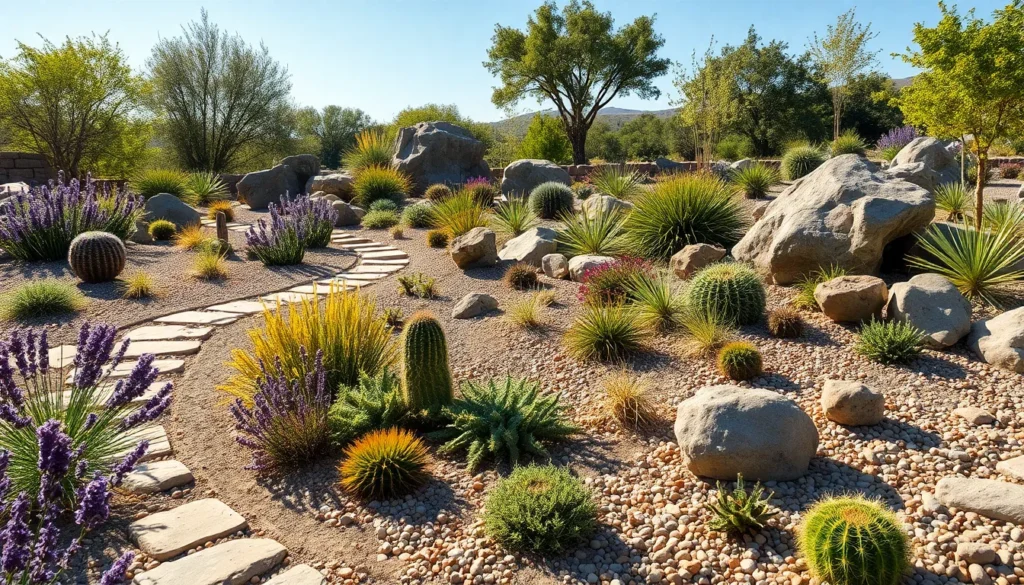Gravel gardens are revolutionizing how we think about low-maintenance landscaping. These stunning drought-resistant spaces offer endless design possibilities while requiring minimal water and upkeep – making them perfect for busy homeowners and eco-conscious gardeners alike.
We’ve discovered that gravel gardens aren’t just practical; they’re incredibly versatile design elements that can transform any outdoor space. From Mediterranean-inspired courtyards to modern minimalist retreats, these gardens adapt to virtually any style while providing year-round visual interest.
Whether you’re dealing with challenging soil conditions, water restrictions, or simply want a gorgeous garden that won’t demand weekend after weekend of maintenance, gravel gardens deliver impressive results. We’ll share creative ideas that’ll help you design a striking gravel garden that perfectly suits your space, budget, and lifestyle preferences.
Choose the Right Location for Your Gravel Garden
Location selection forms the foundation of any successful gravel garden project. We need to carefully evaluate several key factors before breaking ground.
Assess Sun and Shade Patterns
Full sun areas receive 6-8 hours of direct sunlight daily and work best for most gravel garden plants like lavender, ornamental grasses, and succulents. We recommend observing your yard throughout different seasons since tree canopies change dramatically from winter to summer.
Partial shade locations get 3-6 hours of sunlight and can still support beautiful gravel gardens with the right plant selections. Hostas, ferns, and shade-tolerant grasses thrive in these conditions when paired with decorative stones.
Dense shade areas present challenges but aren’t impossible for gravel garden installation. We suggest focusing on architectural elements like sculptural rocks, interesting pathways, and shade-loving ground covers in these spots.
Track sunlight patterns for at least one week during your intended planting season to make informed decisions. Morning sun differs significantly from harsh afternoon exposure in terms of plant stress and water requirements.
Consider Drainage Requirements
Proper drainage prevents root rot and plant failure in gravel garden settings. We need to identify areas where water naturally flows during heavy rainfall to avoid creating soggy conditions.
Sloped terrain provides excellent natural drainage and creates ever-changing visual interest in gravel garden designs. Gentle slopes of 2-5% work perfectly for most installations without requiring extensive terracing.
Flat areas may need drainage improvements through soil amendments or French drain installation. We can create subtle grading using imported soil to encourage water movement away from plant roots.
Test drainage by digging holes 12 inches deep and filling them with water. Good drainage means water disappears within 24 hours, while standing water indicates potential problems.
Avoid low-lying areas where water naturally collects after storms. These spots often stay wet for extended periods and don’t suit typical gravel garden plants.
Evaluate Soil Conditions
Sandy or loamy soils work best for gravel garden success since they drain quickly and don’t retain excess moisture. We can easily amend these soil types with compost for improved plant nutrition.
Clay soils require important preparation before gravel garden installation. Dense clay holds water and creates anaerobic conditions that kill many drought-tolerant plants we’d typically choose.
Soil pH testing reveals important information about plant compatibility and potential amendment needs. Most gravel garden plants prefer slightly alkaline conditions between 6.5-7.5 pH.
Rocky or shallow soils actually benefit gravel garden aesthetics and functionality. We can work with existing stone formations to create natural-looking transitions between planted and hardscape areas.
Compacted soils need loosening through tilling or double digging before adding gravel mulch. This preparation ensures proper root development and water penetration throughout the growing season.
Select Appropriate Gravel Types and Sizes
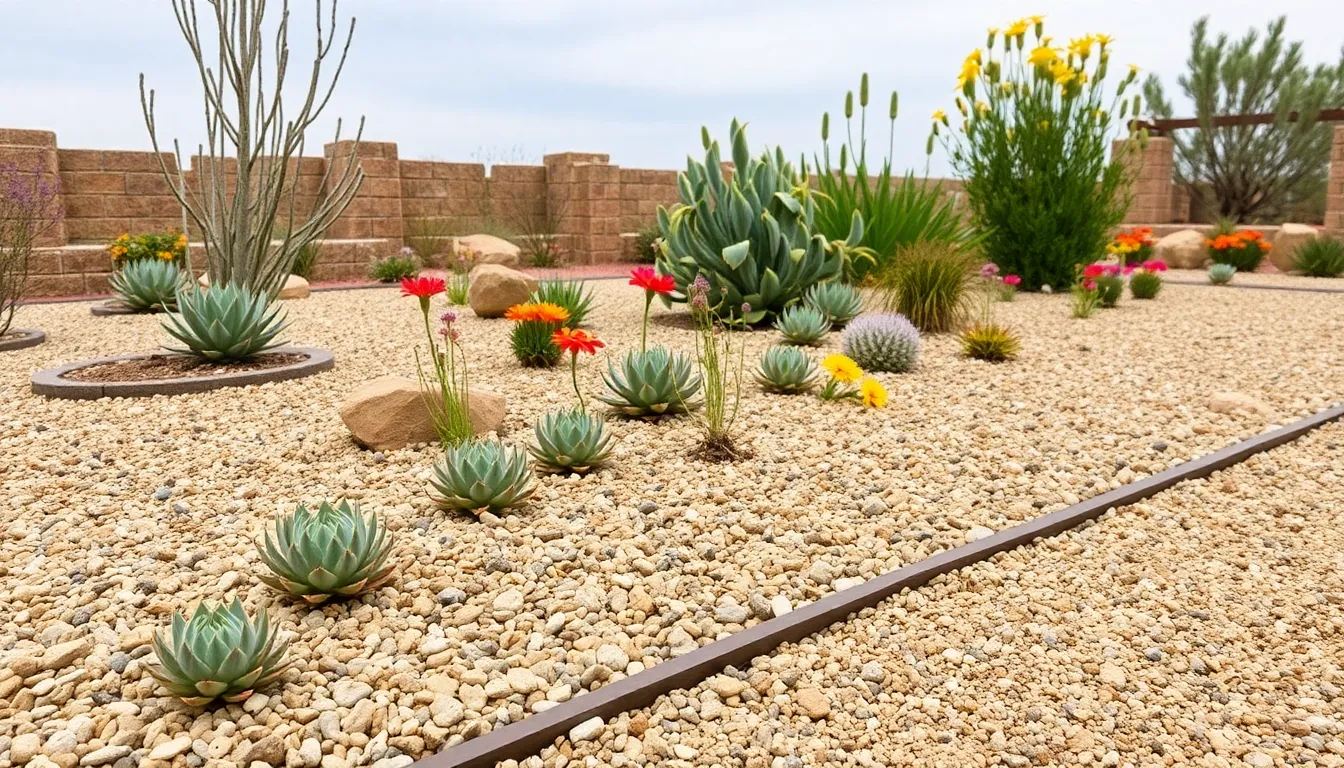
Now that we’ve identified the perfect location for our gravel garden, it’s time to choose the right materials that will form the foundation of our design.
Pea gravel offers exceptional walkability and drainage properties with its smaller stone size. Walking on pea gravel feels comfortable underfoot while allowing water to flow freely through our garden beds.
Crushed stone provides superior stability and compacts easily to create a solid foundation. We can use crushed stone as a base layer to prevent shifting and ensure long term durability.
Decomposed granite combines the appearance of natural soil with enhanced drainage capabilities. This compacted material creates a stable surface that resembles traditional garden soil while preventing water accumulation.
River rock introduces visual texture and works perfectly for defining pathways or creating attractive borders. Larger river rocks add dimensional interest and can serve as focal points throughout our gravel garden design.
Decorative Gravel Options
Rock and gravel combinations create stunning natural aesthetics when paired with drought tolerant plants like succulents and wildflowers. These arrangements require minimal maintenance while providing year round visual appeal.
Metal edging adds rustic charm and creates sharp contrast against our chosen gravel materials. Strategic placement of metal borders helps define garden zones and prevents gravel migration into surrounding areas.
Succulent and wildflower integration transforms functional gravel spaces into living landscapes. These drought resistant plants thrive in gravel conditions and reduce our long term maintenance requirements significantly.
Functional Gravel Considerations
Weed membrane installation beneath our gravel prevents unwanted plant growth and reduces ongoing maintenance tasks. Proper membrane placement creates a barrier that allows drainage while blocking weed germination.
Base preparation involves compacting sand or crushed stone layers to stabilize our gravel surface. This foundation work ensures our gravel garden maintains its shape and prevents settling over time.
Regular maintenance requires occasional raking to preserve our gravel garden’s pristine appearance. Simple upkeep tasks keep our materials looking fresh and properly distributed throughout the space.
Color Coordination with Industry
Natural harmony emerges when we select gravel colors that blend seamlessly with our surrounding industry elements. Earthy tones create cohesive transitions between our gravel garden and existing outdoor features.
Contrasting elements generate visual interest through strategic color combinations between gravel and stone pavers. These purposeful contrasts highlight exact garden areas and create ever-changing focal points.
Modern minimalism pairs light colored gravel with dark stone pavers or concrete surfaces for clean contemporary aesthetics. This approach works exceptionally well in urban settings where sleek design principles dominate.
Incorporate Drought-Tolerant Plants
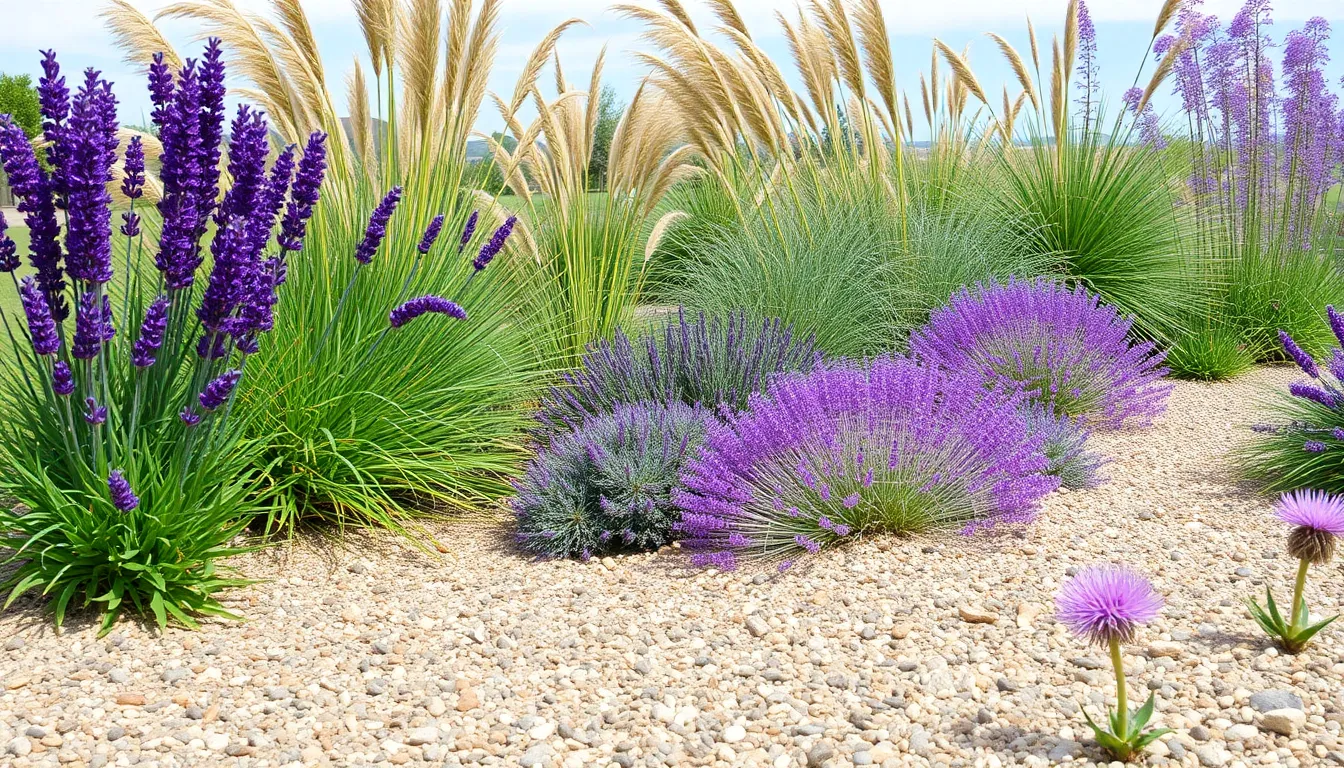
Building on your carefully selected gravel foundation, we’ll now focus on choosing plants that thrive in these well-draining conditions. Drought tolerant species form the backbone of successful gravel gardens, requiring minimal water while delivering maximum visual impact.
Mediterranean Plant Varieties
Lavender stands as our top recommendation for gravel gardens, offering fragrant purple blooms and silvery foliage that complements any stone color palette. This hardy perennial thrives in well-draining conditions and attracts beneficial pollinators throughout the growing season.
Cistus brings vibrant color to Mediterranean-inspired gravel spaces with its papery flowers in shades of white, pink, and purple. These resilient shrubs tolerate extreme heat and drought while providing year-round structure to your garden design.
Eryngiums add architectural interest with their spiky, metallic-blue flower heads that catch light beautifully against neutral gravel tones. Phlomis complements these textures with soft, felted leaves and whorled yellow flowers that create stunning seasonal displays.
Drought-tolerant bulbs extend your garden’s blooming period from early spring through fall. Plant alliums, tulip species, and ornamental onions directly in gravel mulch for naturalized drifts of color that return year after year.
Native Succulent Options
Prickly pear cacti excel in gravel gardens, storing water in their paddle-shaped segments while producing brilliant yellow or red flowers. These native succulents require virtually no maintenance once established and create striking focal points.
Yucca plants provide dramatic vertical elements with their sword-like leaves and towering flower spikes. Choose varieties suited to your climate zone, as these adaptable succulents range from cold-hardy species to tropical specimens.
Sedum varieties spread naturally through gravel mulch, creating living carpets of colorful foliage and star-shaped flowers. Hens and chicks (Sempervivum) form rosette colonies that multiply easily in well-draining gravel conditions.
Agave specimens anchor larger gravel garden designs with their sculptural forms and impressive size. Select cold-hardy varieties for northern climates or container-grown specimens that can overwinter indoors.
Ornamental Grasses for Texture
Pampas grass creates dramatic movement in gravel gardens with its towering plumes that sway gracefully in breezes. Plant this statement grass as a backdrop or corner accent where it has room to reach its full 8-foot height.
Blue oat grass provides soft texture with its steel-blue foliage that maintains color throughout winter months. This compact ornamental grass works perfectly as edging along gravel pathways or grouped in odd-numbered clusters.
Fountain grass offers delicate, flowing plumes that catch morning dew and evening light beautifully. Choose purple-leafed varieties for contrast against light-colored gravel or green cultivars for subtle harmony.
Feather reed grass stands upright even in windy conditions, making it ideal for creating natural screens or privacy barriers in gravel garden designs. Its narrow growth habit allows for tight spacing without overcrowding.
Create Defined Pathways and Borders
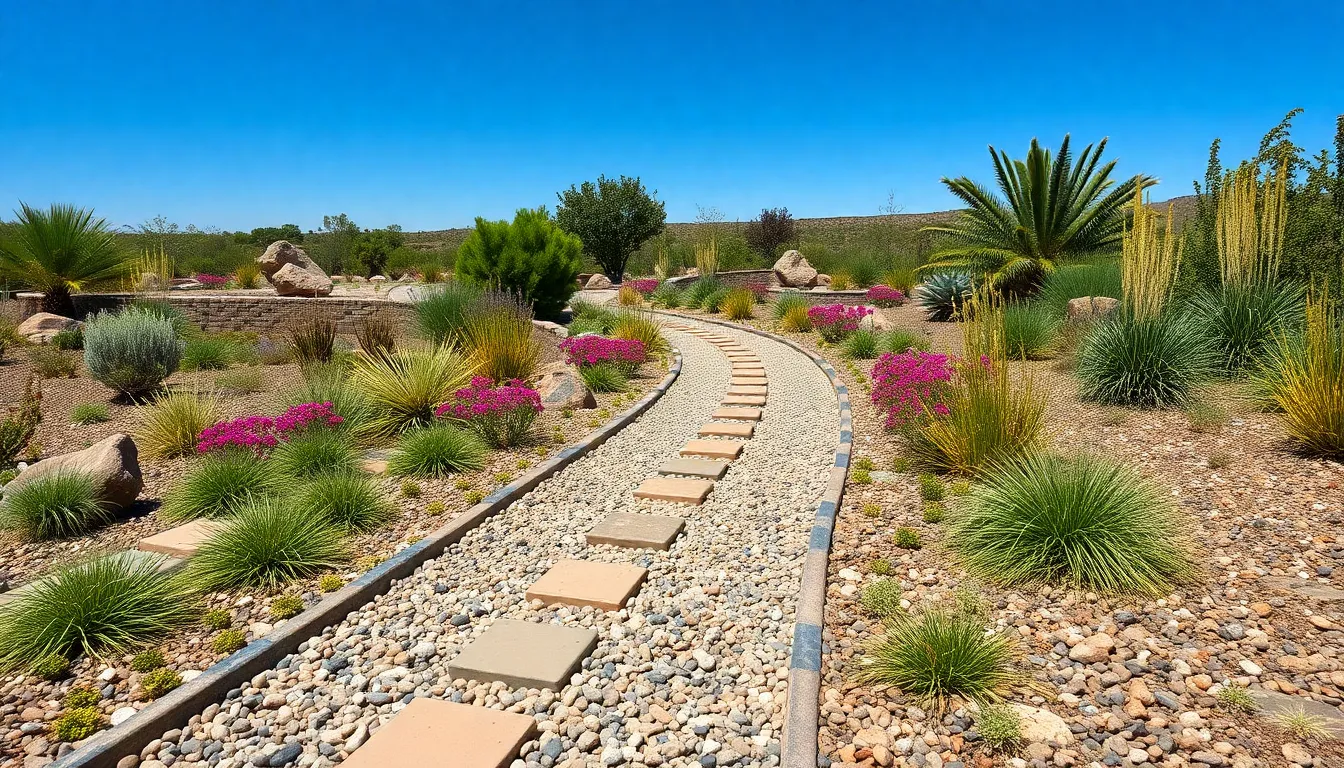
We’ll transform your gravel garden with well-defined pathways and borders that provide structure while maintaining the natural, effortless appeal of your drought-tolerant industry.
Natural Stone Edging
Natural stone edging creates seamless transitions between your gravel areas and planted zones. We recommend limestone, sandstone, or local fieldstone to establish borders that blend organically with your garden’s texture and color palette. Stone edging adds visual weight and permanence to pathway edges while preventing gravel from migrating into adjacent planting beds.
Flat stones work best for creating clean lines along walkways, while irregularly shaped rocks provide a more naturalistic appearance. We suggest varying the stone sizes within your edging to create visual interest and avoid monotonous straight lines. This approach allows your Mediterranean plants like lavender and cistus to spill naturally over the stone borders, softening the overall design.
Metal Border Answers
Metal borders deliver contemporary definition to gravel garden pathways with sleek, minimal profiles. Corten steel strips develop attractive rust patinas over time, complementing the earth tones of decomposed granite and river rock surfaces. Aluminum edging maintains its original finish and works particularly well in modern minimalist designs where clean geometry takes precedence.
We install metal borders flush with the gravel surface to create uninterrupted walking paths while maintaining clear separation between different garden zones. These borders excel at containing fine gravel materials like pea gravel, preventing spillover onto adjacent lawn areas or planted sections. Metal answers require minimal maintenance and provide decades of structural integrity for your pathway system.
Living Plant Borders
Living plant borders soften pathway edges with low-growing, spreading plants that thrive in gravel conditions. Creeping thyme forms dense, fragrant mats that release pleasant aromas when walked upon, while sedum varieties provide colorful, succulent textures along walkway margins. We select plants that naturally spread but won’t become invasive in your exact climate zone.
These living borders create gentle transitions between formal pathways and open gravel areas, allowing your garden to breathe naturally. Ornamental grasses like blue oat grass or dwarf fountain grass add movement and texture while maintaining the drought-tolerant character of your industry. This approach works especially well in Mediterranean-style gardens where plants and hardscape elements blend harmoniously.
Add Structural Elements for Visual Interest
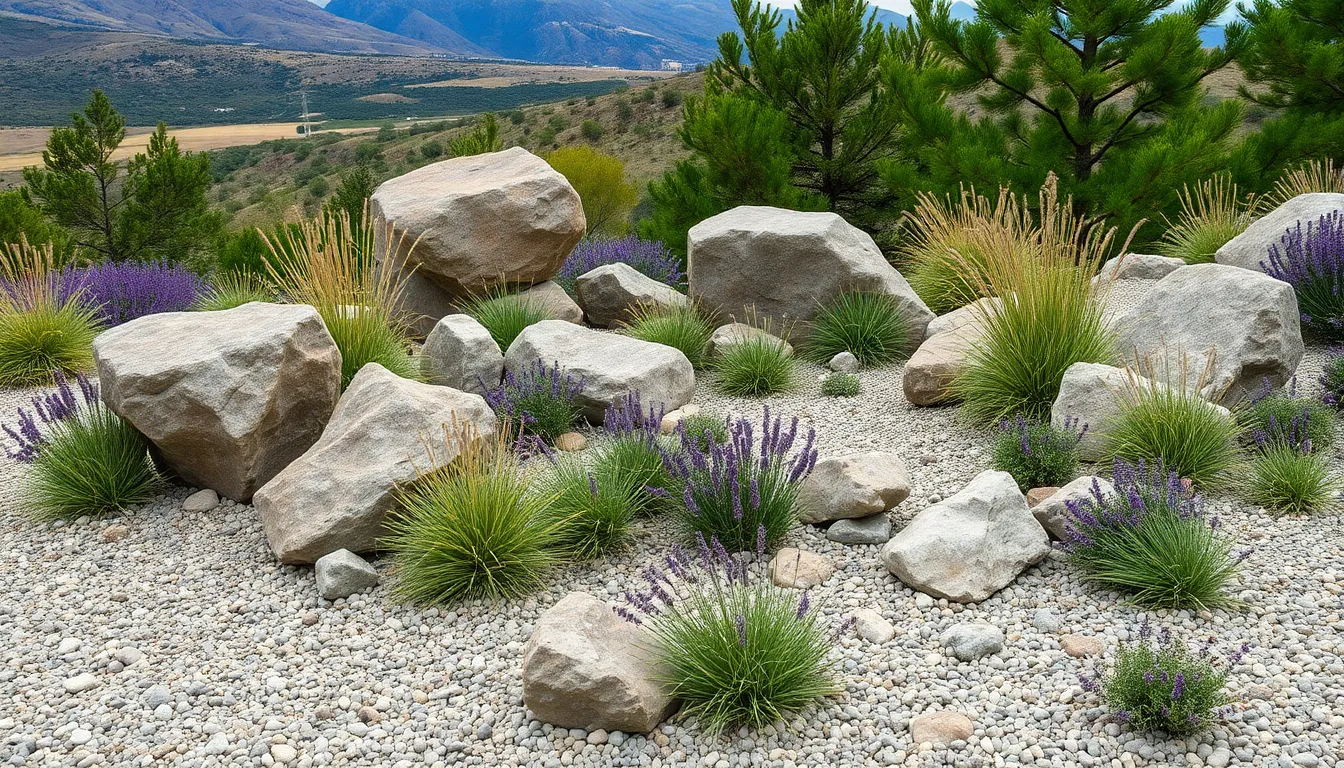
Strategic placement of hardscape features transforms gravel gardens from simple plant collections into ever-changing outdoor spaces. We’ll explore how thoughtful positioning of rocks, boulders, and architectural plants creates compelling focal points.
Boulder Placement Strategies
Strategic placement forms the foundation of effective boulder design in gravel gardens. We position large stones at key viewing angles to guide visitors’ eyes naturally through the space. Placing boulders near seating areas or pathway intersections creates natural gathering spots while maintaining visual balance.
Size variation adds dimensional interest when we combine different boulder scales throughout the garden. Large statement rocks anchor major garden zones, while medium stones create secondary focal points. Smaller boulders fill transitional spaces and provide stepping stone elements for enhanced accessibility.
Asymmetrical groupings generate more natural visual flow than symmetrical arrangements. We cluster odd numbers of boulders together, typically three or five, to create organic compositions that mimic natural rock formations. This approach ensures our gravel gardens feel authentic rather than artificially constructed.
Sculptural Rock Features
Large rock features serve as commanding centerpieces that define garden character and style. We select specimens with distinctive textures, colors, or formations that complement our chosen gravel palette. Upright stones create vertical drama, while horizontal slabs provide natural benching and resting surfaces.
Texture diversity enhances visual complexity when we combine smooth river rocks with rough granite or weathered limestone. Each material contributes unique surface qualities that catch light differently throughout the day. We position textured rocks where morning or evening sun will highlight their distinctive characteristics.
Form considerations influence how we orient each sculptural element within the garden layout. Angular rocks suit contemporary designs and pair well with geometric gravel patterns. Rounded boulders complement naturalistic themes and soften harsh architectural lines from nearby structures.
Architectural Plant Specimens
Drought tolerant plants like lavender, rosemary, and sage provide structural backbone while requiring minimal irrigation maintenance. We position these Mediterranean herbs near boulder groupings to create layered compositions that combine hardscape and softscape elements. Their silvery foliage contrasts beautifully against darker stone surfaces.
Ornamental grasses introduce movement and seasonal interest through their flowing textures and changing colors. We plant fountain grass, blue oat grass, and feather reed grass in strategic clusters that soften boulder edges. These grasses create natural screens while maintaining the open, airy feeling essential to gravel garden design.
Targeted irrigation systems ensure architectural plants receive adequate moisture without overwatering the entire garden space. We install drip irrigation lines specifically around key plant specimens, allowing us to maintain lush focal points while keeping water usage minimal. This approach supports plant health while preserving the garden’s drought resistant character.
Design Water-Wise Planting Schemes

Creating effective water conservation through strategic plant selection transforms your gravel garden into a sustainable industry masterpiece. We’ll explore combinations that thrive with minimal irrigation while maximizing visual impact throughout the seasons.
Xerophytic Plant Combinations
Succulents and cacti form the backbone of our drought resistant garden design, requiring virtually no supplemental watering once established. Prickly pear cacti paired with barrel cacti create striking geometric contrasts against smooth river rock backgrounds.
Ornamental grasses add movement and texture to complement your xerophytic plantings while maintaining excellent drought tolerance. Blue oat grass combined with fountain grass creates ever-changing seasonal interest as stems sway with desert breezes.
Mediterranean herbs deliver fragrance and functionality when grouped strategically throughout gravel beds. Lavender clusters interspersed with rosemary and sage provide aromatic pathways while attracting beneficial pollinators to your water wise industry.
Mixing plant heights creates visual depth without increasing water requirements significantly. Tall yucca specimens anchored by low growing sedum groundcovers establish natural layering that mimics desert network patterns.
Seasonal Color Planning
Spring bulbs planted strategically provide early season color before summer heat intensifies water conservation needs. Tulips and daffodils naturalized in gravel pockets deliver vibrant blooms using stored winter moisture.
Summer flowering annuals selected for heat tolerance maintain color during peak growing season with minimal irrigation support. Zinnias and marigolds thrive in reflected heat from surrounding gravel while producing continuous blooms.
Fall blooming perennials extend garden interest as temperatures cool and natural rainfall potentially increases. Asters and coneflowers provide nectar sources for migrating butterflies while requiring little supplemental watering.
Winter evergreen elements ensure year round structure when herbaceous plants enter dormancy periods. Dwarf pine varieties or compact juniper shrubs maintain visual weight during months when deciduous plants rest.
Low-Maintenance Plant Groupings
Drought tolerant shrubs establish permanent framework requiring minimal intervention once root systems develop fully. Boxwood and yew varieties adapt well to gravel garden conditions when supported by efficient drip irrigation systems.
Texture combinations create visual interest while simplifying maintenance requirements across different plant groupings. Smooth succulent leaves contrasted with spiky ornamental grass blades eliminate need for frequent replanting or pruning.
Native wildflowers provide effortless naturalization that reduces long term garden maintenance while supporting local network health. Regional prairie flower mixes establish self sustaining colonies that return annually without replanting efforts.
Strategic plant spacing reduces competition for available moisture while allowing each specimen room to reach mature proportions. Proper spacing intervals prevent overcrowding that would necessitate frequent watering or plant replacement cycles.
Install Proper Drainage Systems
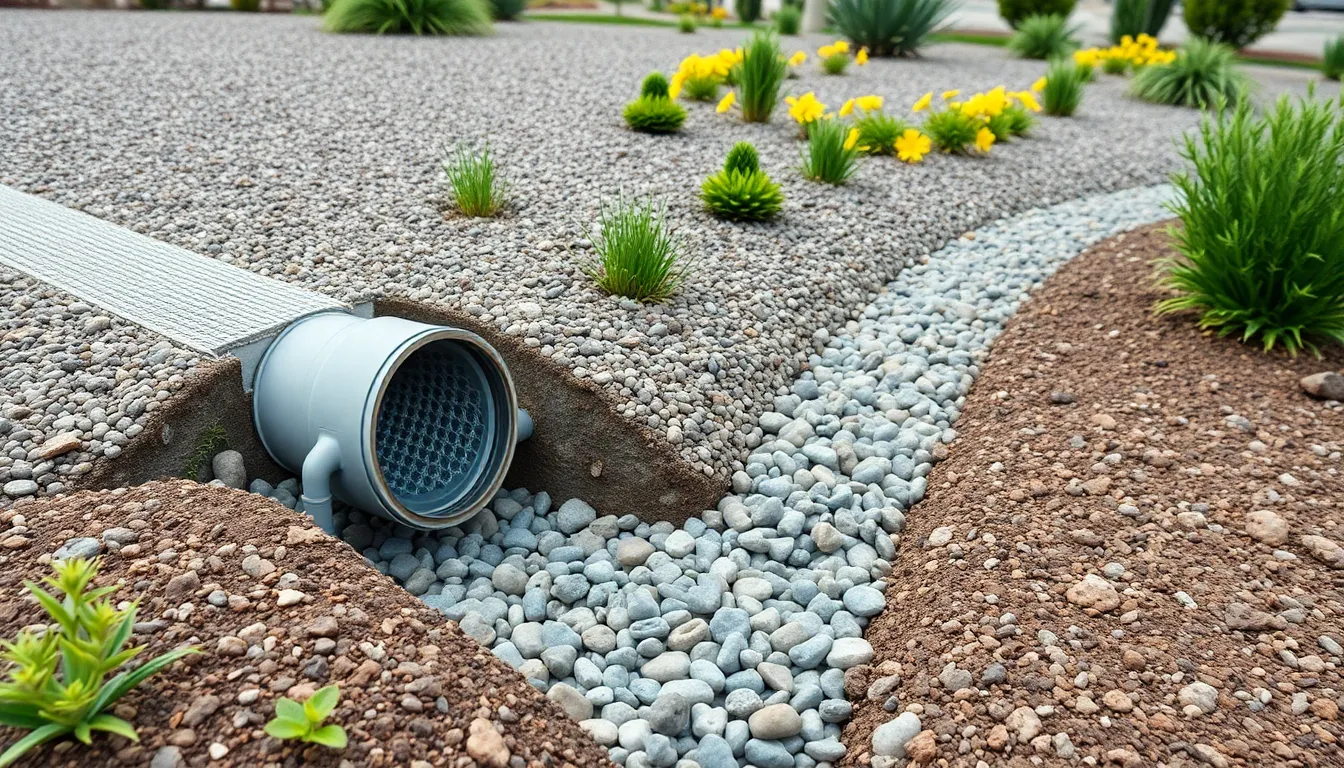
Proper drainage forms the foundation of every successful gravel garden since most drought-tolerant plants can’t survive in waterlogged conditions. We’ll explore three essential drainage techniques that prevent root rot while maintaining the dry conditions your gravel garden plants need to thrive.
French Drain Installation
French drains create the most effective linear drainage solution for gravel gardens by collecting and redirecting excess groundwater away from planted areas. These systems work by gravity, channeling water through a perforated pipe surrounded by gravel within a fabric-lined trench.
Installing your French drain starts with selecting a slope that allows gravity-assisted water flow toward a safe outlet point. We excavate a trench approximately 12-18 inches deep and 6-8 inches wide, ensuring the slope maintains at least a 1% grade for proper drainage. Industry fabric lines the entire trench to prevent soil from clogging the system while allowing water to pass through.
Perforated drainage pipe gets placed at the bottom of the trench with holes facing downward to collect groundwater effectively. Gravel backfill surrounds the pipe completely, creating a continuous drainage channel that prevents water accumulation. This system proves particularly valuable for Mediterranean and drought-tolerant plants that require consistently dry root zones.
Gravel Base Preparation
Base preparation determines the long-term success of your gravel garden by creating stable, well-draining conditions for both plants and gravel materials. We remove existing grass or vegetation completely, then improve soil structure by incorporating amendments that enhance drainage and prevent compaction.
Clay soils require the most extensive preparation since they naturally retain water and create poor drainage conditions. Adding coarse sand, perlite, or small gravel to clay soil improves water movement by creating larger pore spaces between soil particles. Organic matter like compost also helps, but we use it sparingly to avoid creating water-retentive conditions.
Weed barrier membrane gets installed over the prepared soil base to suppress unwanted vegetation while maintaining water permeability. We spread our chosen gravel evenly over the membrane, maintaining a depth of 2-4 inches for optimal weed suppression and moisture retention. Compacting the base layer prevents settling and creates a stable foundation that won’t shift over time.
Slope Management Techniques
Slope management prevents erosion and water pooling while creating visually appealing gravel garden zones that work with your industry’s natural contours. Gentle slopes away from structures encourage proper runoff without creating erosion problems or water stagnation areas.
Terracing transforms steeper slopes into manageable planting areas by creating flat zones separated by gravel walkways or retaining elements. Each terrace level provides stable growing conditions for plants while preventing gravel from washing downhill during heavy rainfall. Stone or timber retaining walls can define these levels while adding structural interest to the design.
Edging materials hold gravel in place on sloped areas by creating physical barriers that prevent migration. Metal edging, natural stone borders, or planted groundcover strips all serve this function while adding design elements to your garden. Drought-tolerant groundcovers like creeping thyme or sedum stabilize soil naturally while requiring minimal maintenance once established.
Incorporate Seating and Focal Points
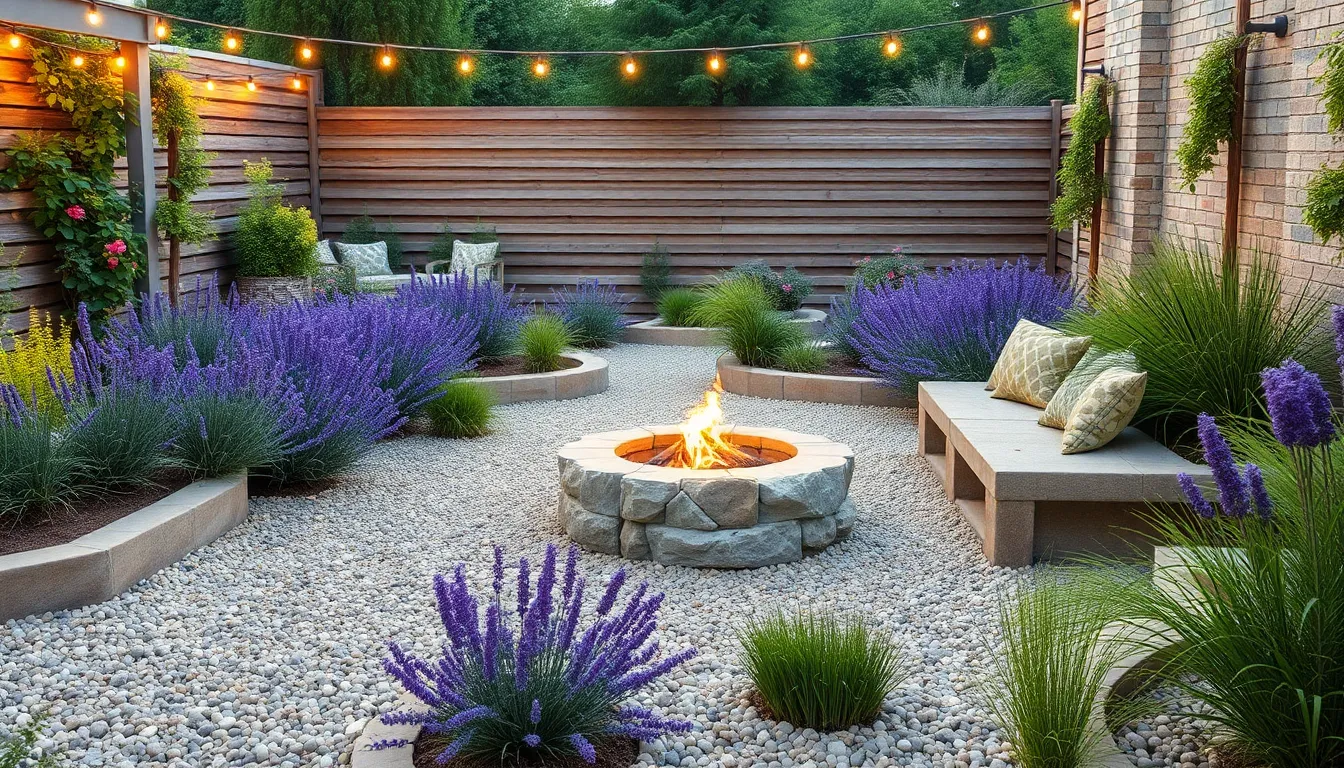
We can transform our gravel garden from a simple industry into an inviting outdoor living space by thoughtfully incorporating seating areas and eye-catching focal points. Strategic placement of these elements creates natural gathering spots while improving the overall visual appeal of our drought-resistant garden design.
Natural Stone Seating Areas
Natural stone benches create perfect resting spots within our gravel garden while maintaining the rustic aesthetic we’ve established. Boulder seating offers an organic alternative that blends seamlessly with the surrounding industry, providing comfortable perches for enjoying the garden’s seasonal changes. Stone placement should follow the natural flow of our existing pathways, creating logical stopping points throughout the space.
Weathered limestone benches complement the neutral tones of decomposed granite, while sandstone options pair beautifully with warmer colored gravels like crushed red rock. Positioning these seating elements near fragrant plants like lavender or ornamental grasses enhances the sensory experience of our outdoor space. We’ll want to consider the sun and shade patterns we evaluated during our initial site selection to ensure comfortable seating throughout the day.
Artistic Garden Features
Water features add unexpected visual interest to our gravel garden while supporting the wildlife-friendly elements we’re incorporating. Small ponds create reflective surfaces that contrast beautifully with the textured gravel, while gentle waterfalls provide soothing sounds that enhance the garden’s peaceful atmosphere. Solar-powered water pumps offer energy-efficient operation that aligns with our sustainable gardening approach.
Sculptures and statues serve as striking focal points that personalize our gravel garden design. Metal sculptures weather naturally and develop patina that complements the earth tones of our stone materials. Abstract forms work particularly well in modern minimalist designs, while natural stone carvings enhance Mediterranean-style gardens.
Strategic lighting transforms our gravel garden into an enchanting evening destination. String lights create warm ambient lighting that highlights our architectural plants and sculptural elements. Solar-powered spotlights can illuminate specimen plants or water features without requiring electrical installation, making them ideal for our low-maintenance garden philosophy.
Fire Pit Integration Ideas
Fire pit areas become natural gathering spaces that extend our garden’s usability into cooler months. Gravel provides the perfect fire-safe surface material, while surrounding stone borders define the seating area and contain loose materials. We can create cozy conversation areas by arranging natural stone seating in a circle around the fire feature.
Stepping stones or pavers create structured pathways that lead visitors safely to our fire pit area. These hardscape elements should coordinate with our existing edging materials, whether we’ve chosen natural stone or metal borders for our garden zones. Clear pathways prevent guests from disturbing our carefully planned plant groupings while moving through the space.
Outdoor furniture integration requires selecting weather-resistant materials that complement our gravel garden’s aesthetic. Teak benches age gracefully and pair well with natural stone elements, while powder-coated metal chairs offer durability in contemporary designs. Positioning furniture to take advantage of our prevailing wind patterns ensures comfortable seating while maintaining proper fire safety distances.
Maintain Your Gravel Garden Effectively

We’ll show you essential maintenance practices that keep your gravel garden looking pristine year-round. These proven techniques ensure your drought-tolerant paradise remains healthy and beautiful with minimal effort.
Weed Prevention Strategies
Deep gravel layers serve as our primary defense against unwanted plant growth. Installing thick gravel coverage naturally suppresses weeds by blocking sunlight and creating an inhospitable environment for germination.
Organic mulch application around established plants creates additional weed barriers while enriching the soil. We recommend applying thin mulch layers near plant bases to further prevent weed establishment and conserve moisture.
Strategic plant spacing also prevents weed proliferation by allowing our chosen plants to establish dominance over their growing areas. Dense plantings of ground covers like creeping thyme create natural weed suppression through competitive exclusion.
Gravel Refreshing Schedule
Replenishing gravel every 2-3 years maintains both effectiveness and visual appeal throughout your garden space. Weather conditions and foot traffic gradually disperse gravel particles, requiring periodic renewal to preserve proper coverage depth.
Visual inspection helps determine the optimal timing for gravel refresh projects. We look for areas where the underlying soil becomes visible or where gravel appears significantly thinned out.
Seasonal refreshing works best during spring or fall when plant growth is less active. Adding fresh gravel during these periods minimizes disruption to established root systems and allows for easier application around mature plants.
Plant Care Requirements
Drought-tolerant plants like lavender, rosemary, sage, and ornamental grasses thrive in well-drained gravel garden conditions. These Mediterranean varieties require minimal water once established and provide year-round structure and color.
Targeted irrigation systems deliver precise moisture to exact plants without compromising the garden’s drought-resistant character. Drip irrigation installations ensure water reaches plant roots efficiently while maintaining proper drainage throughout the gravel areas.
Regular pruning maintains plant shape and promotes healthy growth patterns in our gravel garden selections. We trim established plants during their dormant periods to encourage vigorous spring growth and prevent overcrowding.
Plant selection focuses on species that complement gravel garden microclimates and soil conditions. Native varieties often perform best because they’ve adapted to local growing conditions and require less intervention than exotic alternatives.
Conclusion
We’ve explored the essential elements that make gravel gardens both beautiful and practical for today’s homeowners. From selecting the right materials and drought-tolerant plants to creating proper drainage and adding structural elements these gardens offer endless possibilities for creative expression.
The beauty of gravel gardening lies in its adaptability to various climates conditions and design preferences. Whether you’re working with challenging soil or simply want to reduce maintenance these landscapes provide year-round appeal with minimal water requirements.
With proper planning and the right plant selections your gravel garden will become a stunning low-maintenance sanctuary. The investment in quality materials and thoughtful design will reward you with a sustainable outdoor space that thrives for years to come.
Frequently Asked Questions
What is a gravel garden and why should I consider one?
A gravel garden is a low-maintenance landscaping option that uses gravel as the primary ground cover, combined with drought-tolerant plants. It’s ideal for busy homeowners and environmentally conscious gardeners because it requires minimal watering, adapts to various design styles from Mediterranean to modern minimalist, and provides year-round visual appeal while thriving in challenging soil or water-restricted conditions.
How do I choose the right location for my gravel garden?
Select a location with proper drainage and consider sun exposure patterns. Full sun areas work best for most gravel garden plants, though partial shade can support specific selections. Avoid areas with poor drainage or standing water, as this can cause root rot. Sloped terrains are ideal for natural drainage, and sandy or loamy soils are preferable over clay soils.
What types of gravel work best for garden landscaping?
Popular gravel options include pea gravel for walkability and drainage, crushed stone for stability, decomposed granite for a natural appearance, and river rock for visual texture. Choose gravel size based on your needs: smaller gravels work well for pathways, while larger stones create dramatic focal points. Consider color coordination with surrounding elements for visual harmony.
Which plants thrive best in gravel gardens?
Drought-tolerant plants are essential for gravel gardens. Mediterranean varieties like lavender, cistus, and phlomis offer visual impact and resilience. Native succulents such as prickly pear cacti, yucca, and sedum require minimal maintenance. Ornamental grasses like pampas grass, blue oat grass, and fountain grass add texture and movement to the landscape.
How do I create defined pathways and borders in my gravel garden?
Use natural stone edging like limestone or sandstone for seamless transitions between gravel and planted areas. Metal borders such as corten steel or aluminum provide contemporary definition with minimal maintenance. Living plant borders with low-growing species like creeping thyme and sedum can soften edges and create gentle transitions while enhancing the garden’s natural appeal.
What drainage techniques are essential for gravel garden success?
Install French drains to redirect excess groundwater and prepare a stable gravel base for proper drainage. Manage slopes through terracing to prevent erosion and water pooling. Use edging materials to hold gravel in place, ensuring both functionality and aesthetic appeal. Proper drainage is crucial for the survival of drought-tolerant plants.
How can I add visual interest and focal points to my gravel garden?
Incorporate strategically placed rocks, boulders, and architectural plants as focal points. Use size variation and asymmetrical groupings for natural flow. Add sculptural rock features as centerpieces, and include drought-tolerant architectural plants like lavender for structure. Consider water features, sculptures, and strategic lighting to enhance ambiance and create visual interest.
What maintenance does a gravel garden require?
Gravel gardens are low-maintenance but require some care. Use deep gravel layers and organic mulch for weed prevention. Refresh gravel every 2-3 years to maintain visual appeal. Implement targeted irrigation systems for plant care and perform regular pruning to promote healthy growth. Strategic plant spacing helps minimize competition for moisture and reduces overall maintenance needs.
How do I plan for year-round color in my gravel garden?
Create seasonal interest through strategic plant selection. Use spring bulbs for early color, summer annuals for peak season appeal, fall perennials for autumn interest, and winter evergreens for cold-season structure. Combine xerophytic plants like succulents and cacti with ornamental grasses to maintain visual appeal throughout the year while keeping water requirements minimal.
Can I incorporate seating and entertainment areas in my gravel garden?
Yes, gravel gardens can include functional living spaces. Use natural stone benches and boulders for seating that blends with the garden’s aesthetic. Add fire pits as natural gathering spaces and integrate outdoor furniture that complements the design. These elements transform your gravel garden into an inviting outdoor living space while maintaining its low-maintenance character.

